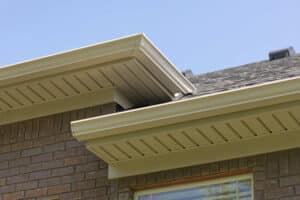
Did you know that your roof needs ventilation? While that might seem counterintuitive at first (opening your roof to the elements), it will make sense with a simple analogy; your roof is like a hat for your home.
If you’ve ever worn a hat, then you know that it can do too good a job sometimes of trapping the warm, moist air around your head, so much so that it can be uncomfortable even in the dead of winter. That’s precisely why many hats come with ventilation of their own or why you might want to pull that hat off for a few moments to get some fresh air. Like a hat, your roof needs to breathe and to breathe, it needs a supply of fresh air. With that said, there are several ventilation options for your roof, so we thought we’d explore the most popular ones.
Ridge Vents
Any roofer worth their salt will ensure that proper ridge vents are installed along the uppermost rid of your roof; think of the top point of a capital “A.” Ridge vents are covered by specially-sized asphalt shingles but have openings along the undersides that allow ventilation. A common problem of an improperly insulated (too humid) attic is due to blocked ridge vents.
Soffit Vents
Soffit vents are located under the eaves of your home and are typically used in homes with existing eaves or roof overhangs. These vents act much like ridge vents; they work passively to allow fresh air in and stale air out of your attic or crawl space.
Not all homes need or can even support soffit vents, particularly older homes. Luckily, there are alternatives to this style of a vent.
Turbine Vent
In place of soffit vents, a roofer might recommend a turbine vent, which is an active source of ventilation by way of an exhaust fan that is cut directly into your roof. A turbine vent will pull air directly from your roof or crawl space, where it will be passively replaced with fresh air.
Gable Vent (Static & Wired)
Gable vents are vents that are typically placed on the face of an existing gable. A static gable vent will use the natural airflow produced by the wind to bring in or replace the air in your attic, much like a soffit or ridge vent.
A wired gable vent works like a turbine vent; it uses a wired exhaust fan that can pull fresh air into the attic.
Attic Fan
Attic fans have never been easier and more effective and are especially effective for those of us who have the components of our central air system running through their attic or crawl space. An attic fan used to have to be wired into the home, which they still can be.
However, a modern solar-powered alternative has found traction in the last decade. Solar-powered attic fans need no wiring and use the power of the sun to run, giving you a sort of “set it and forget it” alternative to your attic ventilation. While we don’t recommend that this be your only source of ventilation, attic fans are a great auxiliary option if your existing ventilation isn’t quite cutting it.

